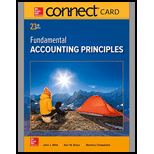
Concept explainers
Absorption costing and Variable costing both are two different costing methods in which cost of product is allocated to that product on different basis of allocation.
Variable costing method is also known as direct costing method or marginal costing. Under variable costing method only variable production cost is assigned to the inventory or cost of goods sold. Variable production cost generally includes direct material, direct labor, direct expenses and variable factory
Absorption costing method is also known as Full costing method. Under this method all direct costs and both fixed and variable factory overheads are applied to the product. Under this method gross profit is calculated by deducting all the direct costs, all fixed and variable overheads such as factory overheads, sales and general administrative expenses both fixed and variable from sales.
To determine:
In the given question we have to describe the procedures to be followed for variable costing income to be converted to absorption costing income.
Want to see the full answer?
Check out a sample textbook solution
Chapter 21 Solutions
Connect Access Card for Fundamental Accounting Principles
- Please provide the answer to this general accounting question with proper steps.arrow_forwardOrville Manufacturing Company's work-in-process inventory on August 1 has a balance of $32,400, representing Job No. 527. During August, $61,500 of direct materials were requisitioned for Job No. 527, and $42,800 of direct labor cost was incurred on Job No. 527. Manufacturing overhead is allocated at 125% of direct labor cost. Actual manufacturing overhead costs incurred in August amounted to $52,500. No new jobs were started during August. Job No. 527 is completed on August 28. Is manufacturing overhead overallocated or underallocated for the month of August and by how much? Answerarrow_forwardNeil Enterprises has total assets of $4,800,000 and liabilities of $1,750,000. The company needs to raise $2,300,000 to purchase new equipment for expansion. They could either borrow the funds using 12-year bonds or issue 200,000 shares of common stock at an estimated market price of $11.50 per share. What is the debt-to-equity ratio before any choices are made? solve this financial accounting problemarrow_forward

 AccountingAccountingISBN:9781337272094Author:WARREN, Carl S., Reeve, James M., Duchac, Jonathan E.Publisher:Cengage Learning,
AccountingAccountingISBN:9781337272094Author:WARREN, Carl S., Reeve, James M., Duchac, Jonathan E.Publisher:Cengage Learning, Accounting Information SystemsAccountingISBN:9781337619202Author:Hall, James A.Publisher:Cengage Learning,
Accounting Information SystemsAccountingISBN:9781337619202Author:Hall, James A.Publisher:Cengage Learning, Horngren's Cost Accounting: A Managerial Emphasis...AccountingISBN:9780134475585Author:Srikant M. Datar, Madhav V. RajanPublisher:PEARSON
Horngren's Cost Accounting: A Managerial Emphasis...AccountingISBN:9780134475585Author:Srikant M. Datar, Madhav V. RajanPublisher:PEARSON Intermediate AccountingAccountingISBN:9781259722660Author:J. David Spiceland, Mark W. Nelson, Wayne M ThomasPublisher:McGraw-Hill Education
Intermediate AccountingAccountingISBN:9781259722660Author:J. David Spiceland, Mark W. Nelson, Wayne M ThomasPublisher:McGraw-Hill Education Financial and Managerial AccountingAccountingISBN:9781259726705Author:John J Wild, Ken W. Shaw, Barbara Chiappetta Fundamental Accounting PrinciplesPublisher:McGraw-Hill Education
Financial and Managerial AccountingAccountingISBN:9781259726705Author:John J Wild, Ken W. Shaw, Barbara Chiappetta Fundamental Accounting PrinciplesPublisher:McGraw-Hill Education





